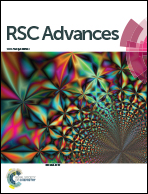Theoretical investigation of the chemoselectivity and synchronously pyrazole ring formation mechanism from ethoxymethylenemalononitrile and hydrazine hydrate in the gas and solvent phases: DFT, meta-GGA studies and NBO analysis†
Abstract
In this work, structural and kinetic aspects of pyrazole (P) ring formation by the reaction of ethoxymethylenemalononitrile (R1) and hydrazine hydrate (R2) were theoretically studied in the gas and solvent phases. Two major possible mechanisms were considered. One of them was initiated by nucleophilic attack of nitrogen atom of R2 on carbon atom of C![[double bond, length as m-dash]](https://www.rsc.org/images/entities/char_e001.gif) C double bond of R1 (Route 1) and the other was started by nucleophilic attack of nitrogen atom of R2 on carbon atom of cyanide group in R1 (Route 2). In order to investigate the solvent effect on the reaction mechanism, all the possible paths were reconsidered in methanol as the solvent. Obtained results showed that the most probable path is route 2 in the gas and solvent phases. Theoretical studies showed that the chemoselectivity of the nucleophilic attack of nitrogen atom in the gas phase is similar to the solvent. Solvent was able to decrease the barrier energy of the rate determining step and enforce the reaction to proceed through subroute 5 of route 2.
C double bond of R1 (Route 1) and the other was started by nucleophilic attack of nitrogen atom of R2 on carbon atom of cyanide group in R1 (Route 2). In order to investigate the solvent effect on the reaction mechanism, all the possible paths were reconsidered in methanol as the solvent. Obtained results showed that the most probable path is route 2 in the gas and solvent phases. Theoretical studies showed that the chemoselectivity of the nucleophilic attack of nitrogen atom in the gas phase is similar to the solvent. Solvent was able to decrease the barrier energy of the rate determining step and enforce the reaction to proceed through subroute 5 of route 2.


 Please wait while we load your content...
Please wait while we load your content...